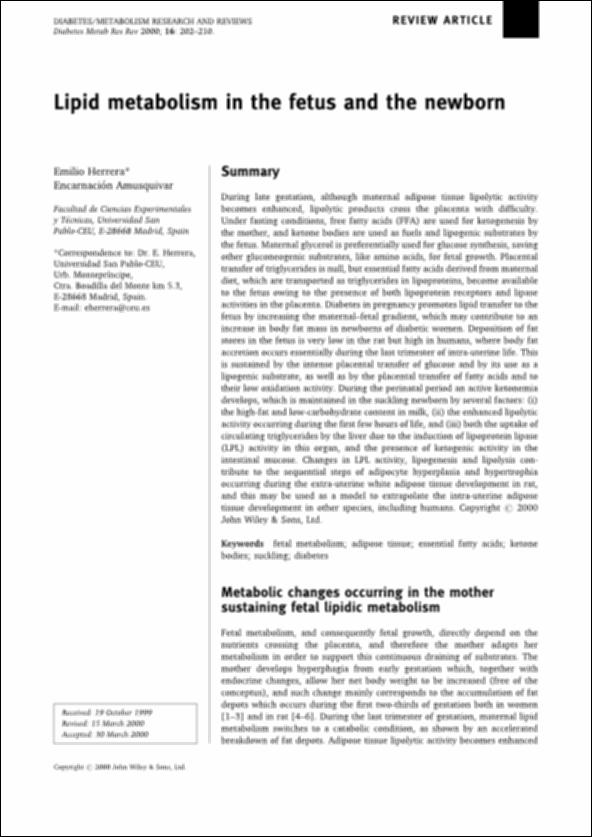Please use this identifier to cite or link to this item:
http://hdl.handle.net/10637/748Lipid metabolism in the fetus and the newborn.
| Title: | Lipid metabolism in the fetus and the newborn. |
| Authors : | Herrera Castillón, Emilio. Amusquivar Arias, Encarnación |
| Keywords: | fetal metabolism; adipose tissue; essential fatty acids; ketone bodies; suckling; diabetes |
| Abstract: | During late gestation, although maternal adipose tissue lipolytic activity becomes enhanced, lipolytic products cross the placenta with dif®culty. Under fasting conditions, free fatty acids (FFA) are used for ketogenesis by the mother, and ketone bodies are used as fuels and lipogenic substrates by the fetus. Maternal glycerol is preferentially used for glucose synthesis, saving other gluconeogenic substrates, like amino acids, for fetal growth. Placental transfer of triglycerides is null, but essential fatty acids derived from maternal diet, which are transported as triglycerides in lipoproteins, become available to the fetus owing to the presence of both lipoprotein receptors and lipase activities in the placenta. Diabetes in pregnancy promotes lipid transfer to the fetus by increasing the maternal±fetal gradient, which may contribute to an increase in body fat mass in newborns of diabetic women. Deposition of fat stores in the fetus is very low in the rat but high in humans, where body fat accretion occurs essentially during the last trimester of intra-uterine life. This is sustained by the intense placental transfer of glucose and by its use as a lipogenic substrate, as well as by the placental transfer of fatty acids and to their low oxidation activity. During the perinatal period an active ketonemia develops, which is maintained in the suckling newborn by several factors: (i) the high-fat and low-carbohydrate content in milk, (ii) the enhanced lipolytic activity occurring during the ®rst few hours of life, and (iii) both the uptake of circulating triglycerides by the liver due to the induction of lipoprotein lipase (LPL) activity in this organ, and the presence of ketogenic activity in the intestinal mucose. Changes in LPL activity, lipogenesis and lipolysis contribute to the sequential steps of adipocyte hyperplasia and hypertrophia occurring during the extra-uterine white adipose tissue development in rat, and this may be used as a model to extrapolate the intra-uterine adipose tissue development in other species, including humans. |
| Description: | En: Diabetes metabolism research and reviews. 2000. n.16 : 202-210 p. 1520-7560 |
| URI: | http://hdl.handle.net/10637/748 |
| Rights : | http://creativecommons.org/licenses/by-nc-nd/4.0/deed.es |
| Issue Date: | 2000 |
| Center : | Universidad San Pablo-CEU |
| Appears in Collections: | Facultad de Farmacia |
Items in DSpace are protected by copyright, with all rights reserved, unless otherwise indicated.


